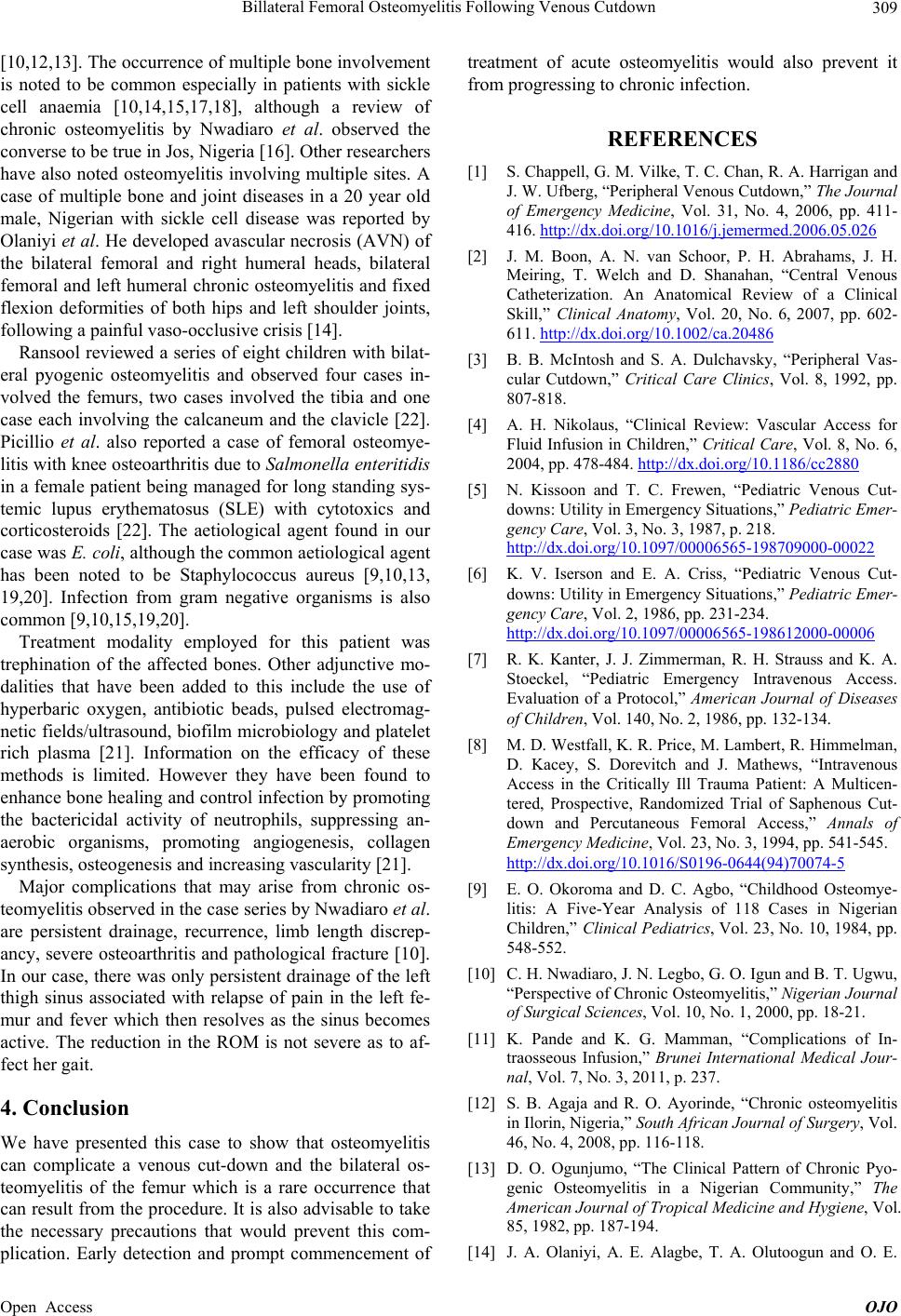
Billateral Femoral Osteomyelitis Following Venous Cutdown 309
[10,12,13]. The o ccurrence of multiple bone inv olvement
is noted to be common especially in patients with sickle
cell anaemia [10,14,15,17,18], although a review of
chronic osteomyelitis by Nwadiaro et al. observed the
converse to be true in Jos, Nigeria [16]. Other researchers
have also noted osteomyelitis involving multiple sites. A
case of multiple bone and joint diseases in a 20 year old
male, Nigerian with sickle cell disease was reported by
Olaniyi et al. He developed avascular necrosis (AVN) of
the bilateral femoral and right humeral heads, bilateral
femoral and left humeral chronic osteomyelitis and fixed
flexion deformities of both hips and left shoulder joints,
following a painful vaso-occlusive crisis [14].
Ransool reviewed a series of eight children with bilat-
eral pyogenic osteomyelitis and observed four cases in-
volved the femurs, two cases involved the tibia and one
case each involving the calcaneum and the clavicle [22].
Picillio et al. also reported a case of femoral osteomye-
litis with knee osteoarthritis due to Salmonella enteritidis
in a female patient being managed for long standing sys-
temic lupus erythematosus (SLE) with cytotoxics and
corticosteroids [22]. The aetiological agent found in our
case was E. coli, although the common aetiological agent
has been noted to be Staphylococcus aureus [9,10,13,
19,20]. Infection from gram negative organisms is also
common [9,10,15,19,20].
Treatment modality employed for this patient was
trephination of the affected bones. Other adjunctive mo-
dalities that have been added to this include the use of
hyperbaric oxygen, antibiotic beads, pulsed electromag-
netic fields/ultrasound , biofilm microbiology and platelet
rich plasma [21]. Information on the efficacy of these
methods is limited. However they have been found to
enhance bone healing and control infection by promoting
the bactericidal activity of neutrophils, suppressing an-
aerobic organisms, promoting angiogenesis, collagen
synthesis, osteogenesis and increasing vascularity [21].
Major complications that may arise from chronic os-
teomyelitis observed in the case series by Nwadiaro et al.
are persistent drainage, recurrence, limb length discrep-
ancy, severe osteoarthritis and pathological fracture [10].
In our case, there was only persistent drainage of the left
thigh sinus associated with relapse of pain in the left fe-
mur and fever which then resolves as the sinus becomes
active. The reduction in the ROM is not severe as to af-
fect her gait.
4. Conclusion
We have presented this case to show that osteomyelitis
can complicate a venous cut-down and the bilateral os-
teomyelitis of the femur which is a rare occurrence that
can result from the procedure. It is also advisable to take
the necessary precautions that would prevent this com-
plication. Early detection and prompt commencement of
treatment of acute osteomyelitis would also prevent it
from progressing to chronic infection.
REFERENCES
[1] S. Chappell, G. M. Vilke, T. C. Chan, R. A. Harrigan and
J. W. Ufberg, “Peripheral Venous Cutdown,” The Journal
of Emergency Medicine, Vol. 31, No. 4, 2006, pp. 411-
416. http://dx.doi.org/10.1016/j.jemermed.2006.05.026
[2] J. M. Boon, A. N. van Schoor, P. H. Abrahams, J. H.
Meiring, T. Welch and D. Shanahan, “Central Venous
Catheterization. An Anatomical Review of a Clinical
Skill,” Clinical Anatomy, Vol. 20, No. 6, 2007, pp. 602-
611. http://dx.doi.org/10.1002/ca.20486
[3] B. B. McIntosh and S. A. Dulchavsky, “Peripheral Vas-
cular Cutdown,” Critical Care Clinics, Vol. 8, 1992, pp.
807-818.
[4] A. H. Nikolaus, “Clinical Review: Vascular Access for
Fluid Infusion in Children,” Critical Care, Vol. 8, No. 6,
2004, pp. 478-484. http://dx.doi.org/10.1186/cc2880
[5] N. Kissoon and T. C. Frewen, “Pediatric Venous Cut-
downs: Utility in Emergency Situations,” Pediatric Emer-
gency Care, Vol. 3, No. 3, 1987, p. 218.
http://dx.doi.org/10.1097/00006565-198709000-00022
[6] K. V. Iserson and E. A. Criss, “Pediatric Venous Cut-
downs: Utility in Emergency Situations,” Pediatric Emer-
gency Care, Vol. 2, 1986, pp. 231-234.
http://dx.doi.org/10.1097/00006565-198612000-00006
[7] R. K. Kanter, J. J. Zimmerman, R. H. Strauss and K. A.
Stoeckel, “Pediatric Emergency Intravenous Access.
Evaluation of a Protocol,” American Journal of Diseases
of Children, Vol. 140, No. 2, 1986, pp. 132-134.
[8] M. D. Westfall , K. R. Price, M. Lambert, R. Himmelman,
D. Kacey, S. Dorevitch and J. Mathews, “Intravenous
Access in the Critically Ill Trauma Patient: A Multicen-
tered, Prospective, Randomized Trial of Saphenous Cut-
down and Percutaneous Femoral Access,” Annals of
Emergency Medicine, Vol. 23, No. 3, 1994, pp. 541-545.
http://dx.doi.org/10.1016/S0196-0644(94)70074-5
[9] E. O. Okoroma and D. C. Agbo, “Childhood Osteomye-
litis: A Five-Year Analysis of 118 Cases in Nigerian
Children,” Clinical Pediatrics, Vol. 23, No. 10, 1984, pp.
548-552.
[10] C. H. Nwadiaro, J. N. Legbo, G. O. Igun and B. T. Ugwu,
“Perspective of Chronic Osteomyelitis,” Nigerian Journal
of Surgical Sciences, Vol. 10, No. 1, 2000, pp. 18-21.
[11] K. Pande and K. G. Mamman, “Complications of In-
traosseous Infusion,” Brunei International Medical Jour-
nal, Vol. 7, No. 3, 2011, p. 237.
[12] S. B. Agaja and R. O. Ayorinde, “Chronic osteomyelitis
in Ilorin, Nigeria,” South African Journal of Surgery, Vol.
46, No. 4, 2008, pp. 116-118.
[13] D. O. Ogunjumo, “The Clinical Pattern of Chronic Pyo-
genic Osteomyelitis in a Nigerian Community,” The
American Journal of Tropical Medicine and Hygiene, Vol.
85, 1982, pp. 187-194.
[14] J. A. Olaniyi, A. E. Alagbe, T. A. Olutoogun and O. E.
Open Access OJO